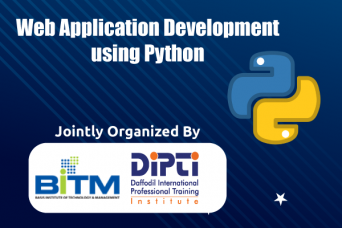- +8809612342486
- [email protected]

The best applications are developing web applications.
This Training is jointly organized by BITM & Daffodil International Professional Training Institute (DIPTI).
Python Course Module
Web Framework of Python
| Class 16 | Real Life Project | 3 Hrs |
| Class 15 | Django's Email Functionality & Deploying Django Applications | 3 Hrs |
| Class 14 | Access Control with Sessions, Users & Generic Views | 3 Hrs |
| Class 13 | Database models & Django Admin Interface | 3 Hrs |
| Class 12 | Django Forms, Django & REST API | 3 Hrs |
| Class 11 | Configuring URLconf's & Django Templates | 3 Hrs |
| Class 10 | How to Create Django View | 3 Hrs |
| Class 09 | Introduction to Django | 3 Hrs |
| Class 08 | Regular Expressions & MySQL Database Access | 3 Hrs |
| Class 07 | Functions & Modules | 3 Hrs |
| Class 06 | Tuples & Dictionary | 3 Hrs |
| Class 05 | Strings & Lists | 3 Hrs |
| Class 04 | Loops & Numbers | 3 Hrs |
| Class 03 | Basic Operators & Decision Making | 3 Hrs |
| Class 02 | Basic Syntax & Variable Types | 3 Hrs |
| Class 01 | Overview & Environment Setup | 3 Hrs |